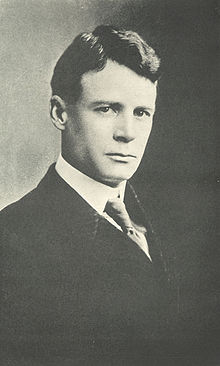Howard Taylor Ricketts | |
|---|---|
 Howard Taylor Ricketts | |
| Born | February 9, 1871 |
| Died | May 3, 1910 (aged 39) |
| Known for | blastomycosis, bacillus, typhus |
| Scientific career | |
| Fields | Bacteriology |
Howard Taylor Ricketts (February 9, 1871 – May 3, 1910) was an American pathologist after whom the family Rickettsiaceae and the order Rickettsiales are named.
He was born in Findlay, Ohio.[1] In the early part of his career, Ricketts undertook research at Northwestern University on blastomycosis. He later worked in the Bitterroot Valley of Montana and at the University of Chicago on Rocky Mountain spotted fever. This early pathology, entomology and epidemiology research in Hamilton, Montana led to the eventual formation of the Rocky Mountain Laboratories there.
While in Montana, Ricketts and his assistant discovered that the vector that carried the pathogen for Rocky Mountain spotted fever is a tick,[2] the Rocky Mountain wood tick (Dermacentor andersoni; some other species of ticks, such as the American dog or wood tick, Dermacentor variabilis, also are vectors). It was not at once clear what kind of organism the pathogen was; eventually it was named Rickettsia, the first of the Rickettsiales to be identified. However, for decades, until electron microscopy and other technologies became sufficiently advanced, it was not known whether Rickettsiales were bacteria, viruses, or something in between. They now are known to be bacteria specialised for intracellular parasitism.[3]
Ricketts was devoted to his research and, on several occasions, injected himself with pathogens to study their effects.[1] The pathogen causing Rocky Mountain spotted fever, Rickettsia rickettsii was named after him. After this eponymous genus, the larger family and order were given their names.
In 1910, Ricketts became interested in a strain of murine-carried typhus known as tabardillo due to a major outbreak in Mexico City, and the apparent similarity of the disease to spotted fever.[1] Days after isolating the organism that he believed caused typhus, he himself died of the disease.[4] His last papers were written in collaboration with R. M. Wilder.
Ricketts was survived by his wife, Myra Tubbs Ricketts, and children. His family established an annual student research prize, the Howard Taylor Ricketts Prize, at the University of Chicago in 1912.[5][6] Noteworthy recipients of the Ricketts Prize include Julian Herman Lewis (1913),[7] Lauretta Bender (1923),[8] Sara Elizabeth Branham (1924), G. M. Dack (1925), and Maurice Hilleman (1945).
- ^ a b c Weiss, Emilio; Strauss, Bernard S. (27 December 1990) [1991], "The Life and Career of Howard Taylor Ricketts", Reviews of Infectious Diseases, 13 (6), The University of Chicago: 1241–2, doi:10.1093/clinids/13.6.1241, PMID 1775858
- ^ Margulis, Lynn; Betsy Palmer Eldridge (2005). "What a Revelation Any Science Is!" (PDF). ASM News. 71 (2). The American Society for Microbiology: 65–70. Archived from the original (PDF) on 22 July 2011. Retrieved 28 April 2011.
- ^ Willey, Joanne; Sherwood, Linda; Woolverton, Chris (2010). Prescott's microbiology (8th ed.). New York: McGraw-Hill Higher Education. ISBN 978-0077350130.
- ^ Enersen, Ole Daniel (1994–2011). "Who Named It? A dictionary of medical eponyms" (website). Retrieved 28 April 2011.
- ^ "Building for a Long Future: The University of Chicago and its donors, 1889 - 1930" (website). The University of Chicago Library. Retrieved 28 April 2011.
- ^ The University Record. University of Chicago Press. 1922. p. 120.
- ^ Cattell, Jaques, ed. (1949). American Men of Science: A Biographical Dictionary. Lancaster, Pennsylvania: The Science Press. p. 1448.
- ^ "The Ricketts Prize for Research". The University of Chicago Magazine. University of Chicago, Alumni Association. 1922. p. 303.